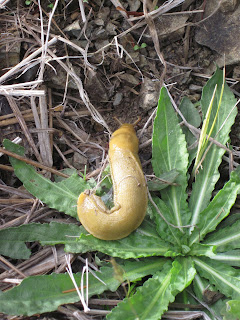 |
| The Drive into the Garcia River Forest |
The property itself has a conservation easement and is comprised of 24,000 acres. The Conservation Fund purchased the tract in 2004 with wildlife conservation and nature conservancy funding, wanting to keep it as forest, not subdivided land. Two thirds of the area provides sustainable timber harvesting while the remainder is dedicated to restoration for species such as Spotted Owl and Koho Salmon habitats.
The land was first cut for logging in the 50's and 60's and again in the 80's and 90's. There are no pure stands of old growth in the Garcia River Forest
Pictured below is our first stop within the forest at a burn site called, "Jack's Fire" which occurred in 2008 due to lightning. Approximately 700 acres burned.
Small patches of area that are affected by fire are typically not removed. Some reasons for this are because it is not economically feasible and is often not necessary. It is also difficult to cut down the small areas as far as physically getting equipment out there to do so.
In areas that you want to harvest, various data is collected and marked such as trees, the parcel as well as water ways within the specific site. Additional information should also include if the site will be for clear cutting or individual tree removal.
 |
| Tree marked by a blue tag indicating its need for removal |
The type of conifer trees found in the forest consists of redwood, Douglas fir and sugar pine. Hardwood trees that are present are the pacific madrone and tan oak.
Trees that can be harvested are limited to small trees and group selection harvesting no bigger than an acre. This is due to the forest being part of the northern spotted owl habitat. In the Garcia River Forest this are a lot of foraging habitat but not roosting habitat. Classifications for each are based off of canopy coverage.
When harvesting you want to make enough growing space for regeneration and to make the forest harvestable in the years to come. This creates growing classes within different parts of the forest.
 |
| Fairly recent harvest area near Jack's Fire burn site |
 |
| Skid Trail |
 |
| Our class looking majestic in the forest with our guide Madison |
Lunch Break! Not a bad view right?!
 |
| The beasts that got us here |
 |
| (She thinks my tractors se...Sustaining timber harvest?...) |
To the river!!!
We continue our journey to the restoration portion of the forest.
The Department of Fish and Game had to get a sixteen-hundred permit in order to add logs into the river for fish habitat which goes against basic loggers instincts (always told to cut trees and bring them away from waterways, never towards them).
Having large wood in rivers offers a number of benefits to the Koho Salmon. They offer direct shelter from enemies such as raccoons, provide shelter during low flow, aid in blockage of high flowing water (fast moving water) that helps salmonoids move upstream and is also where algae can grow and feed baby salmoniods.
When logs are added into the stream they are anchored. Typically they're placed pointing upsteam so when water moves the log it will get locked into the stream. Every log gets a tag to trace them in the future and see if they have moved locations.
 |
| Identity tag on a log in the river |
Felicia's fungi findings!
 |
| found on the path down to the river |
The last stop of the day was looking at coverts. Coverts help direct water runoff from the forest hill slope to the stream. The outflows of coverts are onto rock beds.
One way to divert water runoff from roads is by having angled slopes as well as rolling dips.
Our last find of the day before heading back to Sonoma State!
 |
| Banana Slug! Anyone hungry? |
By: Faye-Marie Pekar










No comments:
Post a Comment